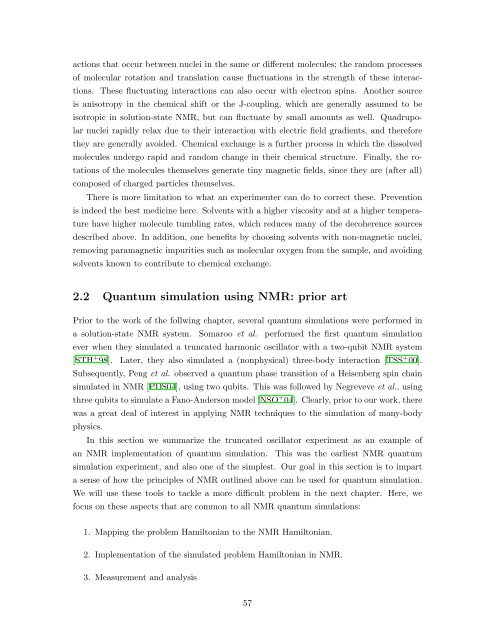Ph.D. Thesis - Physics
Ph.D. Thesis - Physics
Ph.D. Thesis - Physics
You also want an ePaper? Increase the reach of your titles
YUMPU automatically turns print PDFs into web optimized ePapers that Google loves.
actions that occur between nuclei in the same or different molecules; the random processes<br />
of molecular rotation and translation cause fluctuations in the strength of these interac-<br />
tions. These fluctuating interactions can also occur with electron spins. Another source<br />
is anisotropy in the chemical shift or the J-coupling, which are generally assumed to be<br />
isotropic in solution-state NMR, but can fluctuate by small amounts as well. Quadrupo-<br />
lar nuclei rapidly relax due to their interaction with electric field gradients, and therefore<br />
they are generally avoided. Chemical exchange is a further process in which the dissolved<br />
molecules undergo rapid and random change in their chemical structure. Finally, the ro-<br />
tations of the molecules themselves generate tiny magnetic fields, since they are (after all)<br />
composed of charged particles themselves.<br />
There is more limitation to what an experimenter can do to correct these. Prevention<br />
is indeed the best medicine here. Solvents with a higher viscosity and at a higher tempera-<br />
ture have higher molecule tumbling rates, which reduces many of the decoherence sources<br />
described above. In addition, one benefits by choosing solvents with non-magnetic nuclei,<br />
removing paramagnetic impurities such as molecular oxygen from the sample, and avoiding<br />
solvents known to contribute to chemical exchange.<br />
2.2 Quantum simulation using NMR: prior art<br />
Prior to the work of the follwing chapter, several quantum simulations were performed in<br />
a solution-state NMR system. Somaroo et al. performed the first quantum simulation<br />
ever when they simulated a truncated harmonic oscillator with a two-qubit NMR system<br />
[STH + 98]. Later, they also simulated a (nonphysical) three-body interaction [TSS + 00].<br />
Subsequently, Peng et al. observed a quantum phase transition of a Heisenberg spin chain<br />
simulated in NMR [PDS04], using two qubits. This was followed by Negreveve et al., using<br />
three qubits to simulate a Fano-Anderson model [NSO + 04]. Clearly, prior to our work, there<br />
was a great deal of interest in applying NMR techniques to the simulation of many-body<br />
physics.<br />
In this section we summarize the truncated oscillator experiment as an example of<br />
an NMR implementation of quantum simulation. This was the earliest NMR quantum<br />
simulation experiment, and also one of the simplest. Our goal in this section is to impart<br />
a sense of how the principles of NMR outlined above can be used for quantum simulation.<br />
We will use these tools to tackle a more difficult problem in the next chapter. Here, we<br />
focus on these aspects that are common to all NMR quantum simulations:<br />
1. Mapping the problem Hamiltonian to the NMR Hamiltonian.<br />
2. Implementation of the simulated problem Hamiltonian in NMR.<br />
3. Measurement and analysis<br />
57
















